Audit Plan: Financial Statement Analysis of Trunkey Creek Wines
VerifiedAdded on 2023/06/04
|12
|3101
|413
Report
AI Summary
This report outlines the audit planning procedures for Trunkey Creek Wines (TCW) by Miller Yates Howarth (MYH). It includes a ratio analysis over three years to identify high-risk areas and corresponding audit steps. The report assesses the effectiveness of TCW's internal controls and highlights weaknesses in the purchases and accounts payable divisions, providing recommendations for improvement. Key areas of focus include receivable management, profitability, asset utilization, and marketing expenses. The analysis also covers business risks related to liquidity, debt-equity ratio, interest coverage, and inventory management. Effective internal controls, such as IT system management and approval-based ordering, are discussed alongside identified inefficiencies in supplier master file maintenance and invoice checking processes.
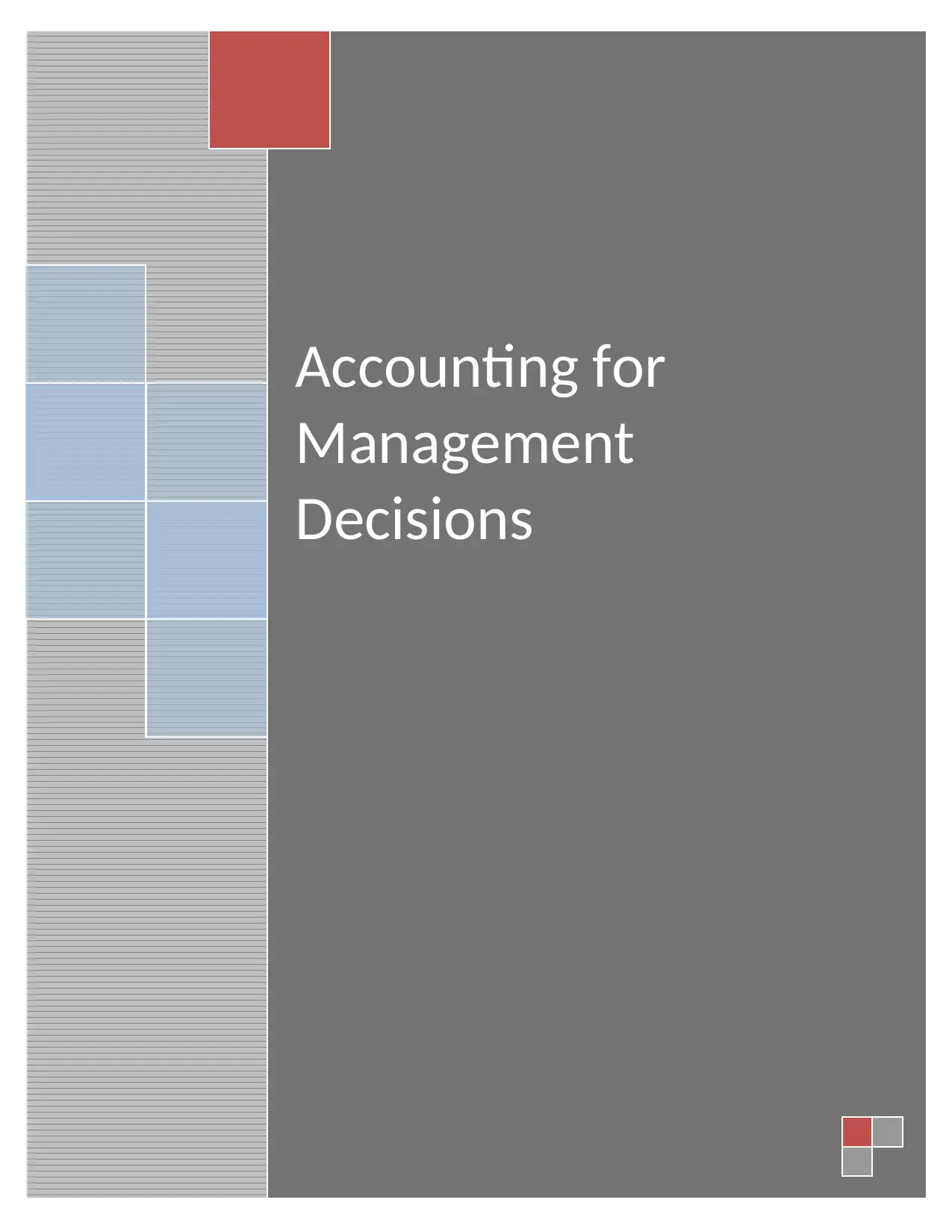
Accounting for
Management
Decisions
Management
Decisions
Paraphrase This Document
Need a fresh take? Get an instant paraphrase of this document with our AI Paraphraser
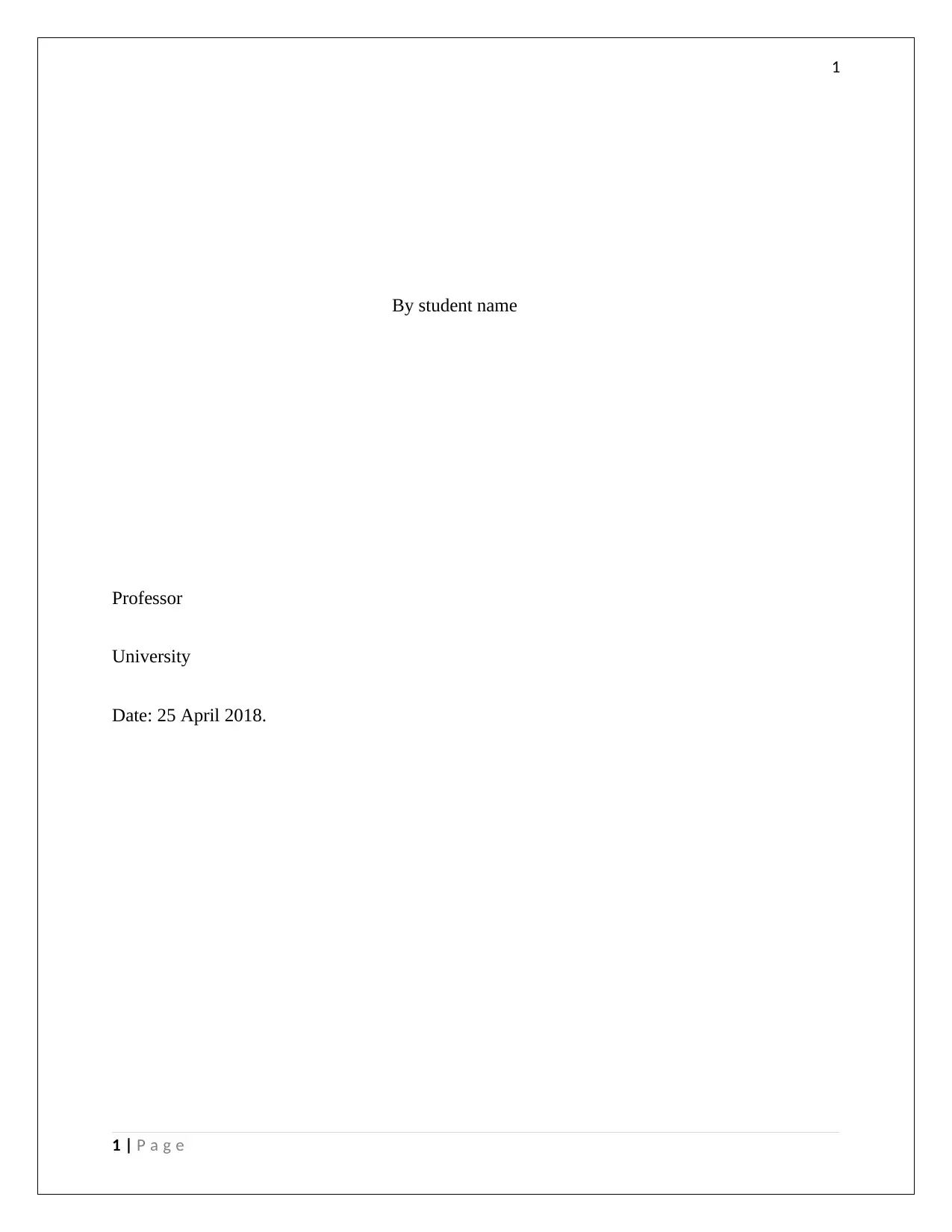
1
By student name
Professor
University
Date: 25 April 2018.
1 | P a g e
By student name
Professor
University
Date: 25 April 2018.
1 | P a g e
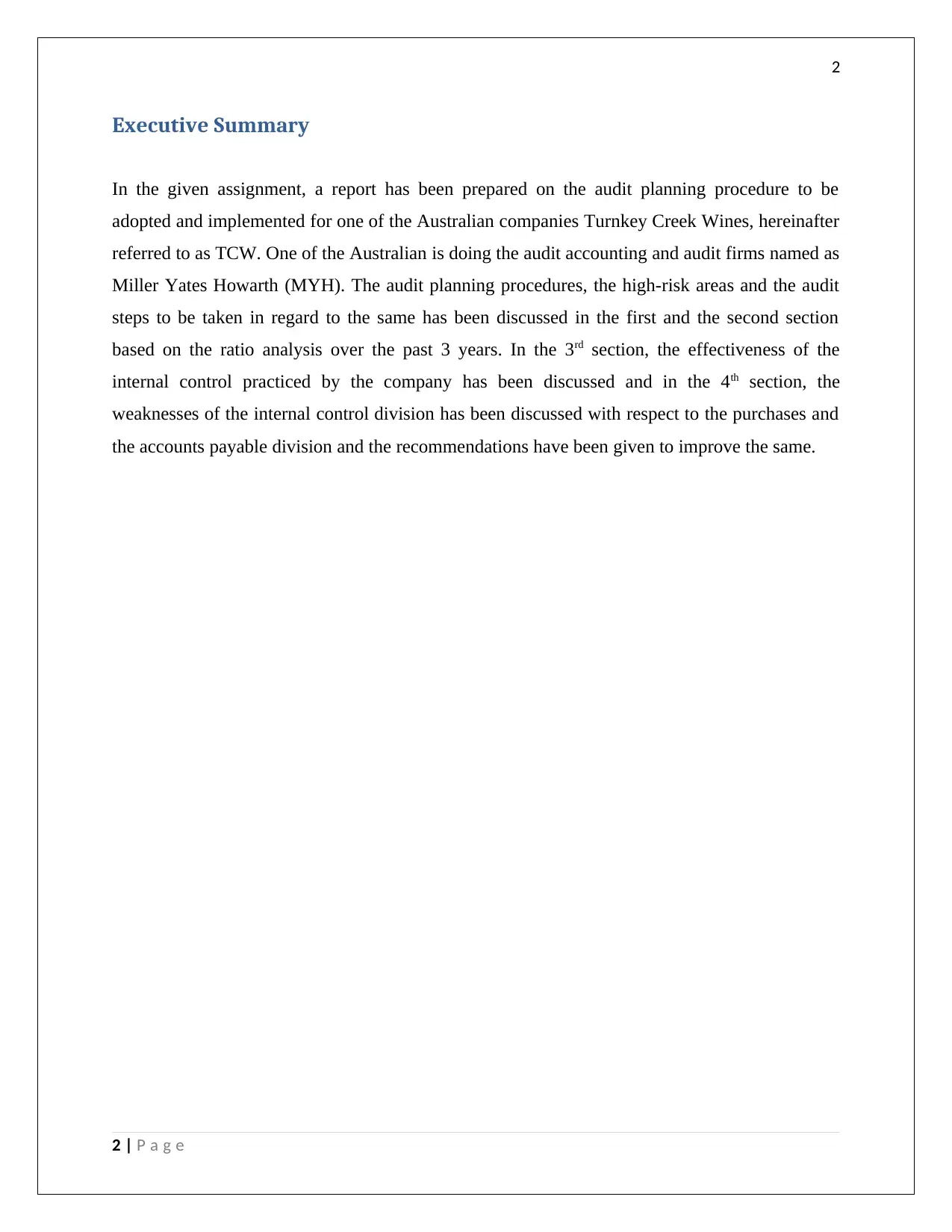
2
Executive Summary
In the given assignment, a report has been prepared on the audit planning procedure to be
adopted and implemented for one of the Australian companies Turnkey Creek Wines, hereinafter
referred to as TCW. One of the Australian is doing the audit accounting and audit firms named as
Miller Yates Howarth (MYH). The audit planning procedures, the high-risk areas and the audit
steps to be taken in regard to the same has been discussed in the first and the second section
based on the ratio analysis over the past 3 years. In the 3rd section, the effectiveness of the
internal control practiced by the company has been discussed and in the 4th section, the
weaknesses of the internal control division has been discussed with respect to the purchases and
the accounts payable division and the recommendations have been given to improve the same.
2 | P a g e
Executive Summary
In the given assignment, a report has been prepared on the audit planning procedure to be
adopted and implemented for one of the Australian companies Turnkey Creek Wines, hereinafter
referred to as TCW. One of the Australian is doing the audit accounting and audit firms named as
Miller Yates Howarth (MYH). The audit planning procedures, the high-risk areas and the audit
steps to be taken in regard to the same has been discussed in the first and the second section
based on the ratio analysis over the past 3 years. In the 3rd section, the effectiveness of the
internal control practiced by the company has been discussed and in the 4th section, the
weaknesses of the internal control division has been discussed with respect to the purchases and
the accounts payable division and the recommendations have been given to improve the same.
2 | P a g e
⊘ This is a preview!⊘
Do you want full access?
Subscribe today to unlock all pages.

Trusted by 1+ million students worldwide
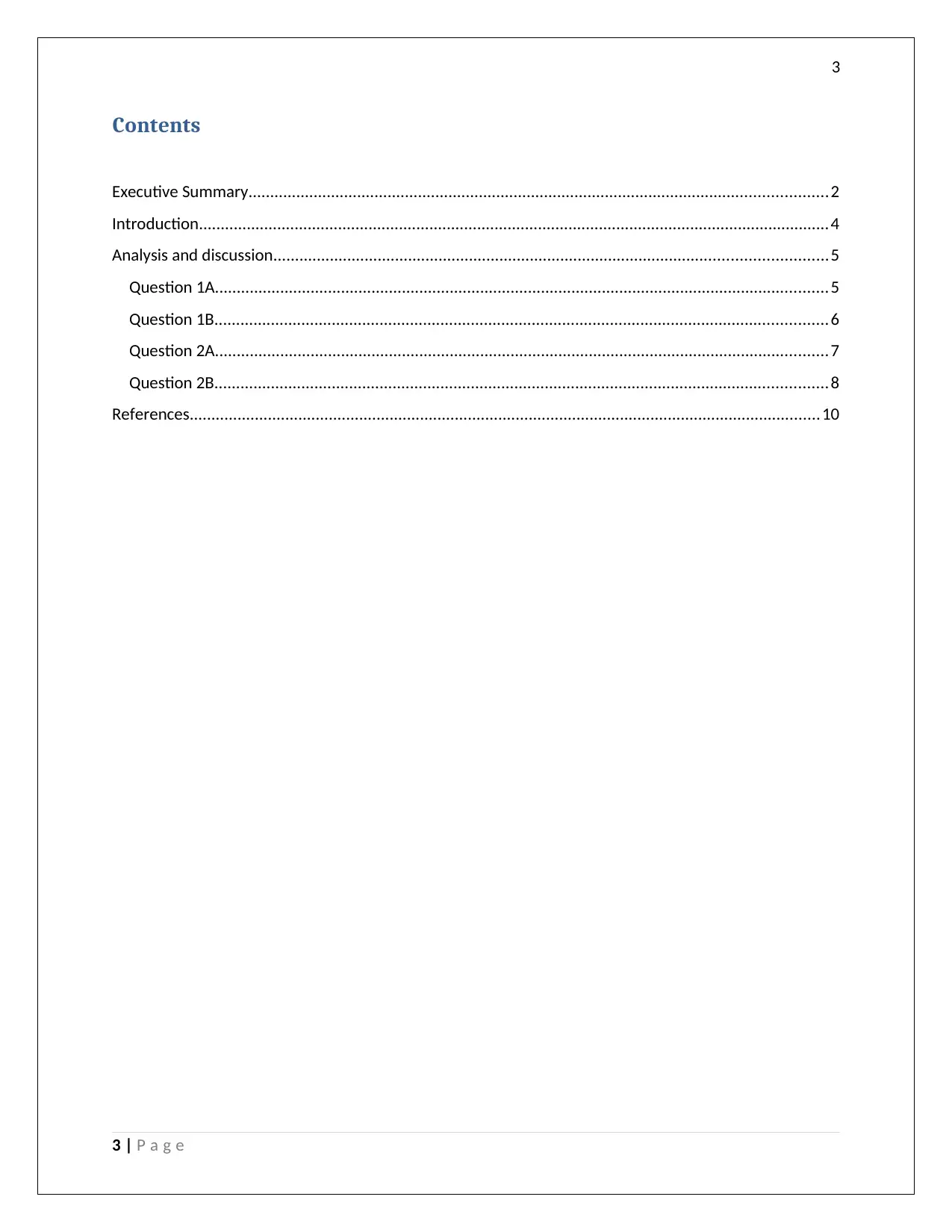
3
Contents
Executive Summary.....................................................................................................................................2
Introduction.................................................................................................................................................4
Analysis and discussion...............................................................................................................................5
Question 1A.............................................................................................................................................5
Question 1B.............................................................................................................................................6
Question 2A.............................................................................................................................................7
Question 2B.............................................................................................................................................8
References.................................................................................................................................................10
3 | P a g e
Contents
Executive Summary.....................................................................................................................................2
Introduction.................................................................................................................................................4
Analysis and discussion...............................................................................................................................5
Question 1A.............................................................................................................................................5
Question 1B.............................................................................................................................................6
Question 2A.............................................................................................................................................7
Question 2B.............................................................................................................................................8
References.................................................................................................................................................10
3 | P a g e
Paraphrase This Document
Need a fresh take? Get an instant paraphrase of this document with our AI Paraphraser
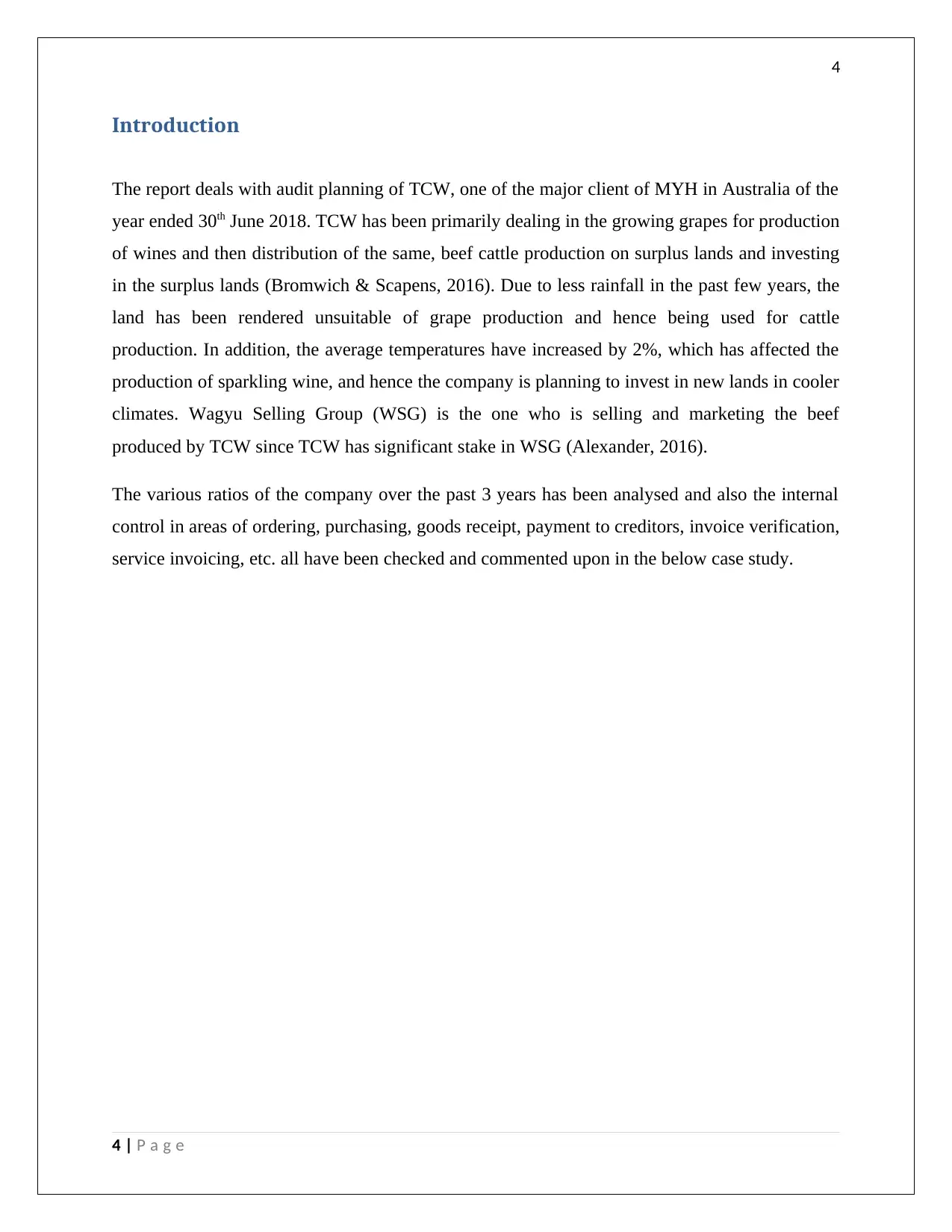
4
Introduction
The report deals with audit planning of TCW, one of the major client of MYH in Australia of the
year ended 30th June 2018. TCW has been primarily dealing in the growing grapes for production
of wines and then distribution of the same, beef cattle production on surplus lands and investing
in the surplus lands (Bromwich & Scapens, 2016). Due to less rainfall in the past few years, the
land has been rendered unsuitable of grape production and hence being used for cattle
production. In addition, the average temperatures have increased by 2%, which has affected the
production of sparkling wine, and hence the company is planning to invest in new lands in cooler
climates. Wagyu Selling Group (WSG) is the one who is selling and marketing the beef
produced by TCW since TCW has significant stake in WSG (Alexander, 2016).
The various ratios of the company over the past 3 years has been analysed and also the internal
control in areas of ordering, purchasing, goods receipt, payment to creditors, invoice verification,
service invoicing, etc. all have been checked and commented upon in the below case study.
4 | P a g e
Introduction
The report deals with audit planning of TCW, one of the major client of MYH in Australia of the
year ended 30th June 2018. TCW has been primarily dealing in the growing grapes for production
of wines and then distribution of the same, beef cattle production on surplus lands and investing
in the surplus lands (Bromwich & Scapens, 2016). Due to less rainfall in the past few years, the
land has been rendered unsuitable of grape production and hence being used for cattle
production. In addition, the average temperatures have increased by 2%, which has affected the
production of sparkling wine, and hence the company is planning to invest in new lands in cooler
climates. Wagyu Selling Group (WSG) is the one who is selling and marketing the beef
produced by TCW since TCW has significant stake in WSG (Alexander, 2016).
The various ratios of the company over the past 3 years has been analysed and also the internal
control in areas of ordering, purchasing, goods receipt, payment to creditors, invoice verification,
service invoicing, etc. all have been checked and commented upon in the below case study.
4 | P a g e
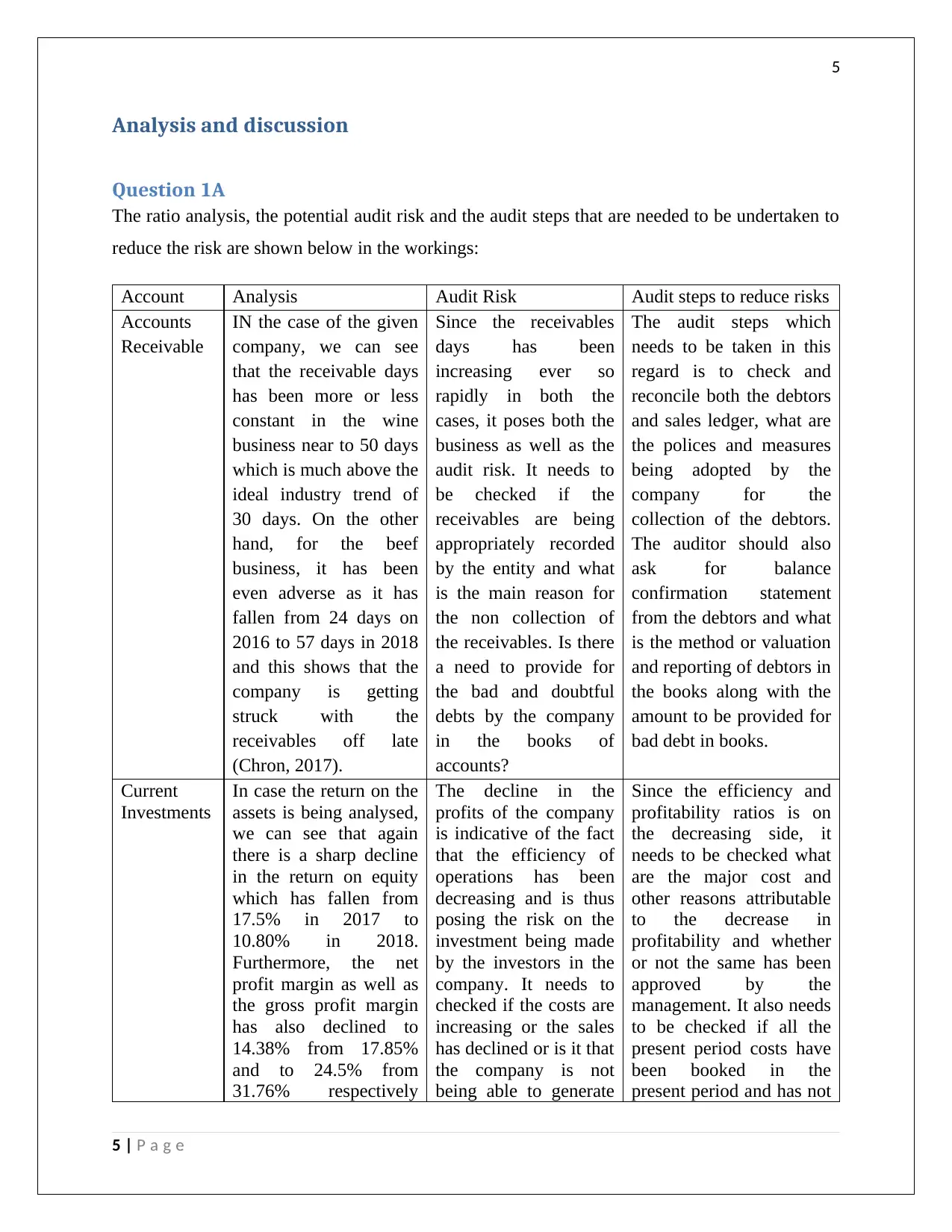
5
Analysis and discussion
Question 1A
The ratio analysis, the potential audit risk and the audit steps that are needed to be undertaken to
reduce the risk are shown below in the workings:
Account Analysis Audit Risk Audit steps to reduce risks
Accounts
Receivable
IN the case of the given
company, we can see
that the receivable days
has been more or less
constant in the wine
business near to 50 days
which is much above the
ideal industry trend of
30 days. On the other
hand, for the beef
business, it has been
even adverse as it has
fallen from 24 days on
2016 to 57 days in 2018
and this shows that the
company is getting
struck with the
receivables off late
(Chron, 2017).
Since the receivables
days has been
increasing ever so
rapidly in both the
cases, it poses both the
business as well as the
audit risk. It needs to
be checked if the
receivables are being
appropriately recorded
by the entity and what
is the main reason for
the non collection of
the receivables. Is there
a need to provide for
the bad and doubtful
debts by the company
in the books of
accounts?
The audit steps which
needs to be taken in this
regard is to check and
reconcile both the debtors
and sales ledger, what are
the polices and measures
being adopted by the
company for the
collection of the debtors.
The auditor should also
ask for balance
confirmation statement
from the debtors and what
is the method or valuation
and reporting of debtors in
the books along with the
amount to be provided for
bad debt in books.
Current
Investments
In case the return on the
assets is being analysed,
we can see that again
there is a sharp decline
in the return on equity
which has fallen from
17.5% in 2017 to
10.80% in 2018.
Furthermore, the net
profit margin as well as
the gross profit margin
has also declined to
14.38% from 17.85%
and to 24.5% from
31.76% respectively
The decline in the
profits of the company
is indicative of the fact
that the efficiency of
operations has been
decreasing and is thus
posing the risk on the
investment being made
by the investors in the
company. It needs to
checked if the costs are
increasing or the sales
has declined or is it that
the company is not
being able to generate
Since the efficiency and
profitability ratios is on
the decreasing side, it
needs to be checked what
are the major cost and
other reasons attributable
to the decrease in
profitability and whether
or not the same has been
approved by the
management. It also needs
to be checked if all the
present period costs have
been booked in the
present period and has not
5 | P a g e
Analysis and discussion
Question 1A
The ratio analysis, the potential audit risk and the audit steps that are needed to be undertaken to
reduce the risk are shown below in the workings:
Account Analysis Audit Risk Audit steps to reduce risks
Accounts
Receivable
IN the case of the given
company, we can see
that the receivable days
has been more or less
constant in the wine
business near to 50 days
which is much above the
ideal industry trend of
30 days. On the other
hand, for the beef
business, it has been
even adverse as it has
fallen from 24 days on
2016 to 57 days in 2018
and this shows that the
company is getting
struck with the
receivables off late
(Chron, 2017).
Since the receivables
days has been
increasing ever so
rapidly in both the
cases, it poses both the
business as well as the
audit risk. It needs to
be checked if the
receivables are being
appropriately recorded
by the entity and what
is the main reason for
the non collection of
the receivables. Is there
a need to provide for
the bad and doubtful
debts by the company
in the books of
accounts?
The audit steps which
needs to be taken in this
regard is to check and
reconcile both the debtors
and sales ledger, what are
the polices and measures
being adopted by the
company for the
collection of the debtors.
The auditor should also
ask for balance
confirmation statement
from the debtors and what
is the method or valuation
and reporting of debtors in
the books along with the
amount to be provided for
bad debt in books.
Current
Investments
In case the return on the
assets is being analysed,
we can see that again
there is a sharp decline
in the return on equity
which has fallen from
17.5% in 2017 to
10.80% in 2018.
Furthermore, the net
profit margin as well as
the gross profit margin
has also declined to
14.38% from 17.85%
and to 24.5% from
31.76% respectively
The decline in the
profits of the company
is indicative of the fact
that the efficiency of
operations has been
decreasing and is thus
posing the risk on the
investment being made
by the investors in the
company. It needs to
checked if the costs are
increasing or the sales
has declined or is it that
the company is not
being able to generate
Since the efficiency and
profitability ratios is on
the decreasing side, it
needs to be checked what
are the major cost and
other reasons attributable
to the decrease in
profitability and whether
or not the same has been
approved by the
management. It also needs
to be checked if all the
present period costs have
been booked in the
present period and has not
5 | P a g e
⊘ This is a preview!⊘
Do you want full access?
Subscribe today to unlock all pages.

Trusted by 1+ million students worldwide
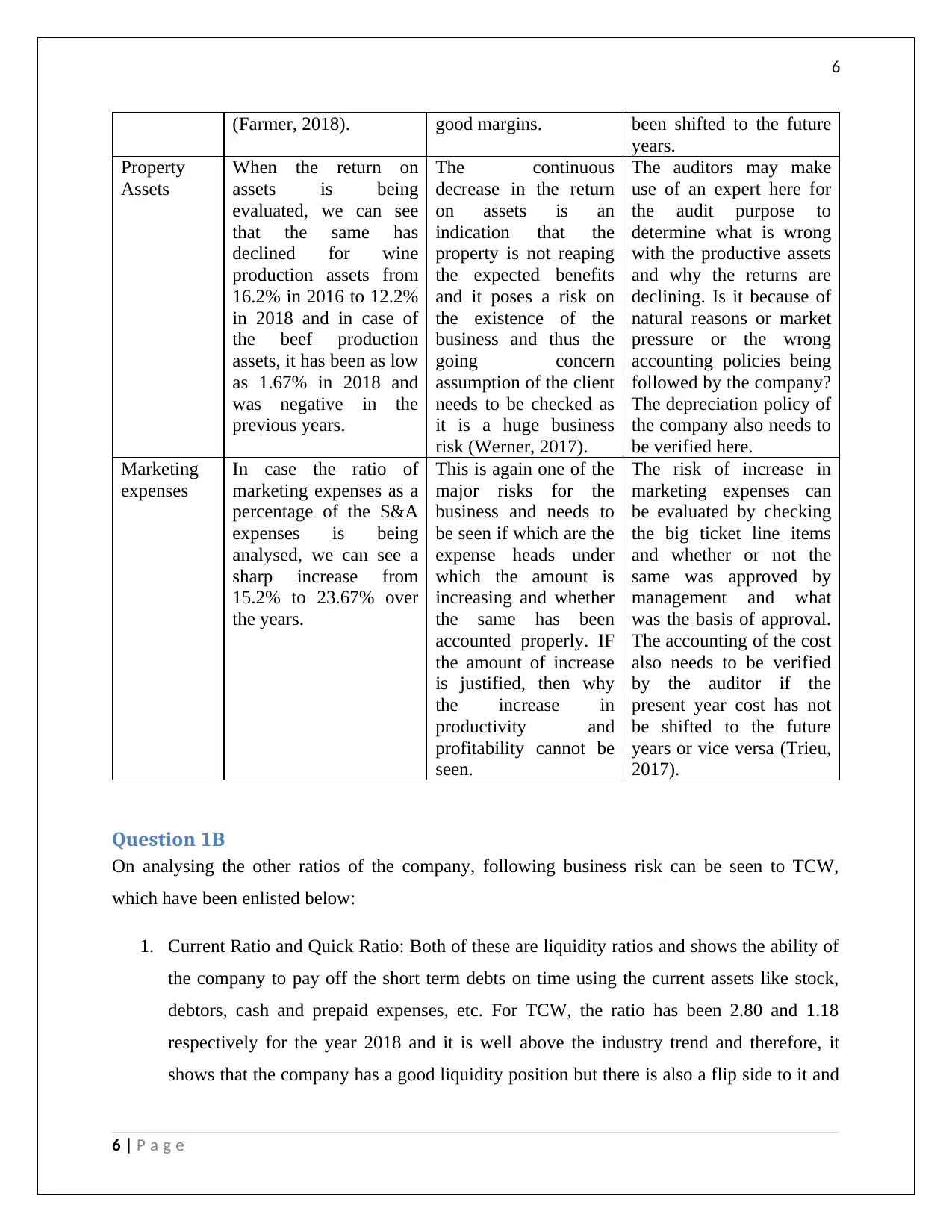
6
(Farmer, 2018). good margins. been shifted to the future
years.
Property
Assets
When the return on
assets is being
evaluated, we can see
that the same has
declined for wine
production assets from
16.2% in 2016 to 12.2%
in 2018 and in case of
the beef production
assets, it has been as low
as 1.67% in 2018 and
was negative in the
previous years.
The continuous
decrease in the return
on assets is an
indication that the
property is not reaping
the expected benefits
and it poses a risk on
the existence of the
business and thus the
going concern
assumption of the client
needs to be checked as
it is a huge business
risk (Werner, 2017).
The auditors may make
use of an expert here for
the audit purpose to
determine what is wrong
with the productive assets
and why the returns are
declining. Is it because of
natural reasons or market
pressure or the wrong
accounting policies being
followed by the company?
The depreciation policy of
the company also needs to
be verified here.
Marketing
expenses
In case the ratio of
marketing expenses as a
percentage of the S&A
expenses is being
analysed, we can see a
sharp increase from
15.2% to 23.67% over
the years.
This is again one of the
major risks for the
business and needs to
be seen if which are the
expense heads under
which the amount is
increasing and whether
the same has been
accounted properly. IF
the amount of increase
is justified, then why
the increase in
productivity and
profitability cannot be
seen.
The risk of increase in
marketing expenses can
be evaluated by checking
the big ticket line items
and whether or not the
same was approved by
management and what
was the basis of approval.
The accounting of the cost
also needs to be verified
by the auditor if the
present year cost has not
be shifted to the future
years or vice versa (Trieu,
2017).
Question 1B
On analysing the other ratios of the company, following business risk can be seen to TCW,
which have been enlisted below:
1. Current Ratio and Quick Ratio: Both of these are liquidity ratios and shows the ability of
the company to pay off the short term debts on time using the current assets like stock,
debtors, cash and prepaid expenses, etc. For TCW, the ratio has been 2.80 and 1.18
respectively for the year 2018 and it is well above the industry trend and therefore, it
shows that the company has a good liquidity position but there is also a flip side to it and
6 | P a g e
(Farmer, 2018). good margins. been shifted to the future
years.
Property
Assets
When the return on
assets is being
evaluated, we can see
that the same has
declined for wine
production assets from
16.2% in 2016 to 12.2%
in 2018 and in case of
the beef production
assets, it has been as low
as 1.67% in 2018 and
was negative in the
previous years.
The continuous
decrease in the return
on assets is an
indication that the
property is not reaping
the expected benefits
and it poses a risk on
the existence of the
business and thus the
going concern
assumption of the client
needs to be checked as
it is a huge business
risk (Werner, 2017).
The auditors may make
use of an expert here for
the audit purpose to
determine what is wrong
with the productive assets
and why the returns are
declining. Is it because of
natural reasons or market
pressure or the wrong
accounting policies being
followed by the company?
The depreciation policy of
the company also needs to
be verified here.
Marketing
expenses
In case the ratio of
marketing expenses as a
percentage of the S&A
expenses is being
analysed, we can see a
sharp increase from
15.2% to 23.67% over
the years.
This is again one of the
major risks for the
business and needs to
be seen if which are the
expense heads under
which the amount is
increasing and whether
the same has been
accounted properly. IF
the amount of increase
is justified, then why
the increase in
productivity and
profitability cannot be
seen.
The risk of increase in
marketing expenses can
be evaluated by checking
the big ticket line items
and whether or not the
same was approved by
management and what
was the basis of approval.
The accounting of the cost
also needs to be verified
by the auditor if the
present year cost has not
be shifted to the future
years or vice versa (Trieu,
2017).
Question 1B
On analysing the other ratios of the company, following business risk can be seen to TCW,
which have been enlisted below:
1. Current Ratio and Quick Ratio: Both of these are liquidity ratios and shows the ability of
the company to pay off the short term debts on time using the current assets like stock,
debtors, cash and prepaid expenses, etc. For TCW, the ratio has been 2.80 and 1.18
respectively for the year 2018 and it is well above the industry trend and therefore, it
shows that the company has a good liquidity position but there is also a flip side to it and
6 | P a g e
Paraphrase This Document
Need a fresh take? Get an instant paraphrase of this document with our AI Paraphraser
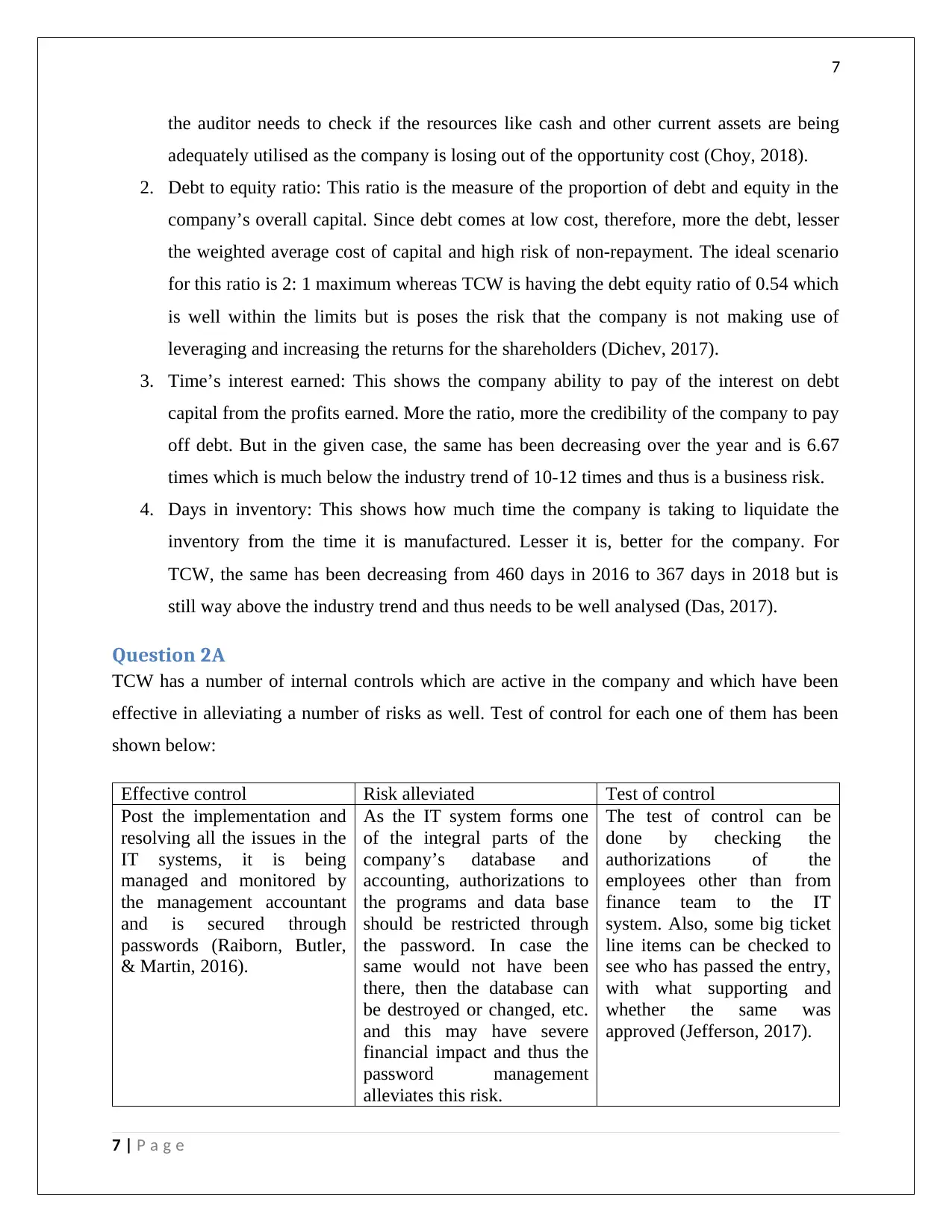
7
the auditor needs to check if the resources like cash and other current assets are being
adequately utilised as the company is losing out of the opportunity cost (Choy, 2018).
2. Debt to equity ratio: This ratio is the measure of the proportion of debt and equity in the
company’s overall capital. Since debt comes at low cost, therefore, more the debt, lesser
the weighted average cost of capital and high risk of non-repayment. The ideal scenario
for this ratio is 2: 1 maximum whereas TCW is having the debt equity ratio of 0.54 which
is well within the limits but is poses the risk that the company is not making use of
leveraging and increasing the returns for the shareholders (Dichev, 2017).
3. Time’s interest earned: This shows the company ability to pay of the interest on debt
capital from the profits earned. More the ratio, more the credibility of the company to pay
off debt. But in the given case, the same has been decreasing over the year and is 6.67
times which is much below the industry trend of 10-12 times and thus is a business risk.
4. Days in inventory: This shows how much time the company is taking to liquidate the
inventory from the time it is manufactured. Lesser it is, better for the company. For
TCW, the same has been decreasing from 460 days in 2016 to 367 days in 2018 but is
still way above the industry trend and thus needs to be well analysed (Das, 2017).
Question 2A
TCW has a number of internal controls which are active in the company and which have been
effective in alleviating a number of risks as well. Test of control for each one of them has been
shown below:
Effective control Risk alleviated Test of control
Post the implementation and
resolving all the issues in the
IT systems, it is being
managed and monitored by
the management accountant
and is secured through
passwords (Raiborn, Butler,
& Martin, 2016).
As the IT system forms one
of the integral parts of the
company’s database and
accounting, authorizations to
the programs and data base
should be restricted through
the password. In case the
same would not have been
there, then the database can
be destroyed or changed, etc.
and this may have severe
financial impact and thus the
password management
alleviates this risk.
The test of control can be
done by checking the
authorizations of the
employees other than from
finance team to the IT
system. Also, some big ticket
line items can be checked to
see who has passed the entry,
with what supporting and
whether the same was
approved (Jefferson, 2017).
7 | P a g e
the auditor needs to check if the resources like cash and other current assets are being
adequately utilised as the company is losing out of the opportunity cost (Choy, 2018).
2. Debt to equity ratio: This ratio is the measure of the proportion of debt and equity in the
company’s overall capital. Since debt comes at low cost, therefore, more the debt, lesser
the weighted average cost of capital and high risk of non-repayment. The ideal scenario
for this ratio is 2: 1 maximum whereas TCW is having the debt equity ratio of 0.54 which
is well within the limits but is poses the risk that the company is not making use of
leveraging and increasing the returns for the shareholders (Dichev, 2017).
3. Time’s interest earned: This shows the company ability to pay of the interest on debt
capital from the profits earned. More the ratio, more the credibility of the company to pay
off debt. But in the given case, the same has been decreasing over the year and is 6.67
times which is much below the industry trend of 10-12 times and thus is a business risk.
4. Days in inventory: This shows how much time the company is taking to liquidate the
inventory from the time it is manufactured. Lesser it is, better for the company. For
TCW, the same has been decreasing from 460 days in 2016 to 367 days in 2018 but is
still way above the industry trend and thus needs to be well analysed (Das, 2017).
Question 2A
TCW has a number of internal controls which are active in the company and which have been
effective in alleviating a number of risks as well. Test of control for each one of them has been
shown below:
Effective control Risk alleviated Test of control
Post the implementation and
resolving all the issues in the
IT systems, it is being
managed and monitored by
the management accountant
and is secured through
passwords (Raiborn, Butler,
& Martin, 2016).
As the IT system forms one
of the integral parts of the
company’s database and
accounting, authorizations to
the programs and data base
should be restricted through
the password. In case the
same would not have been
there, then the database can
be destroyed or changed, etc.
and this may have severe
financial impact and thus the
password management
alleviates this risk.
The test of control can be
done by checking the
authorizations of the
employees other than from
finance team to the IT
system. Also, some big ticket
line items can be checked to
see who has passed the entry,
with what supporting and
whether the same was
approved (Jefferson, 2017).
7 | P a g e
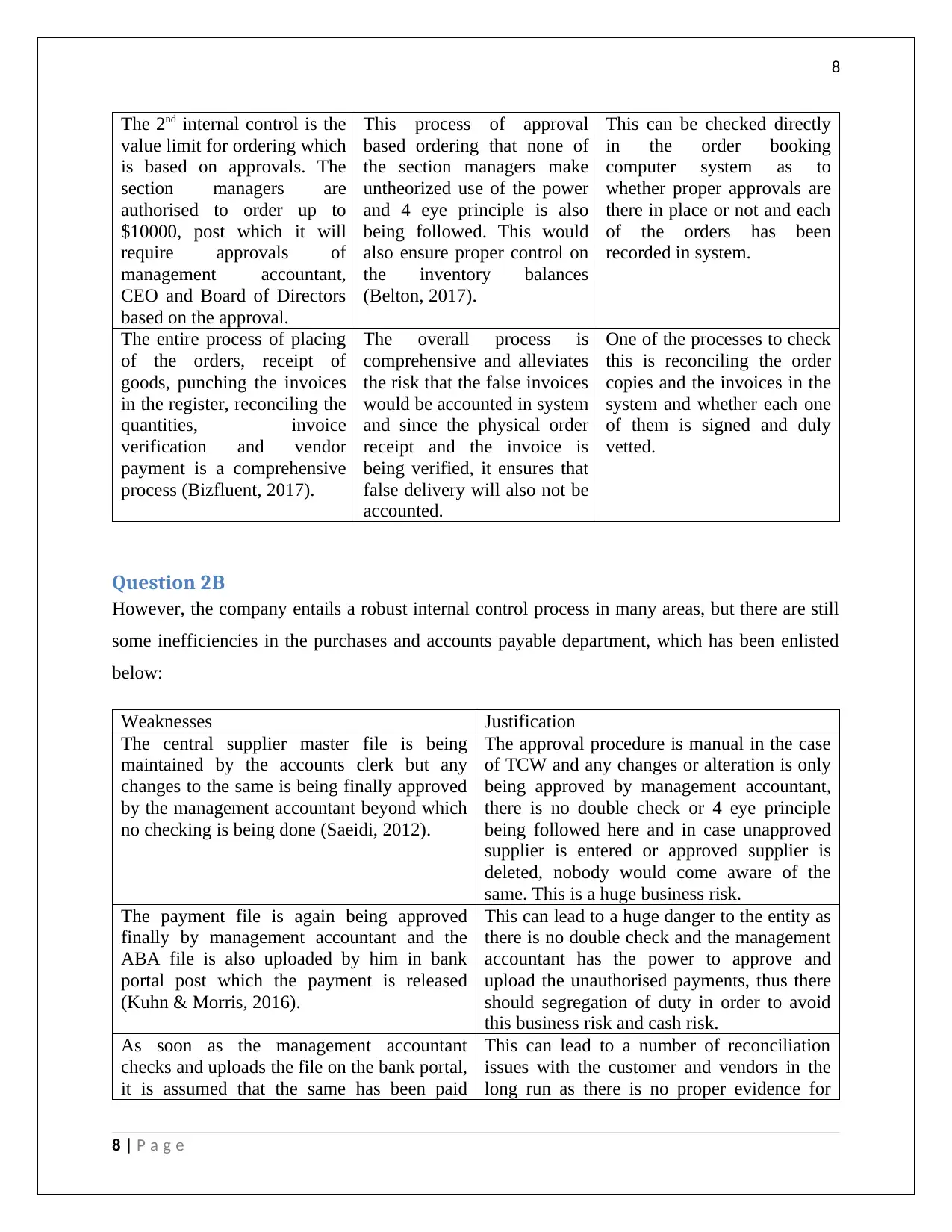
8
The 2nd internal control is the
value limit for ordering which
is based on approvals. The
section managers are
authorised to order up to
$10000, post which it will
require approvals of
management accountant,
CEO and Board of Directors
based on the approval.
This process of approval
based ordering that none of
the section managers make
untheorized use of the power
and 4 eye principle is also
being followed. This would
also ensure proper control on
the inventory balances
(Belton, 2017).
This can be checked directly
in the order booking
computer system as to
whether proper approvals are
there in place or not and each
of the orders has been
recorded in system.
The entire process of placing
of the orders, receipt of
goods, punching the invoices
in the register, reconciling the
quantities, invoice
verification and vendor
payment is a comprehensive
process (Bizfluent, 2017).
The overall process is
comprehensive and alleviates
the risk that the false invoices
would be accounted in system
and since the physical order
receipt and the invoice is
being verified, it ensures that
false delivery will also not be
accounted.
One of the processes to check
this is reconciling the order
copies and the invoices in the
system and whether each one
of them is signed and duly
vetted.
Question 2B
However, the company entails a robust internal control process in many areas, but there are still
some inefficiencies in the purchases and accounts payable department, which has been enlisted
below:
Weaknesses Justification
The central supplier master file is being
maintained by the accounts clerk but any
changes to the same is being finally approved
by the management accountant beyond which
no checking is being done (Saeidi, 2012).
The approval procedure is manual in the case
of TCW and any changes or alteration is only
being approved by management accountant,
there is no double check or 4 eye principle
being followed here and in case unapproved
supplier is entered or approved supplier is
deleted, nobody would come aware of the
same. This is a huge business risk.
The payment file is again being approved
finally by management accountant and the
ABA file is also uploaded by him in bank
portal post which the payment is released
(Kuhn & Morris, 2016).
This can lead to a huge danger to the entity as
there is no double check and the management
accountant has the power to approve and
upload the unauthorised payments, thus there
should segregation of duty in order to avoid
this business risk and cash risk.
As soon as the management accountant
checks and uploads the file on the bank portal,
it is assumed that the same has been paid
This can lead to a number of reconciliation
issues with the customer and vendors in the
long run as there is no proper evidence for
8 | P a g e
The 2nd internal control is the
value limit for ordering which
is based on approvals. The
section managers are
authorised to order up to
$10000, post which it will
require approvals of
management accountant,
CEO and Board of Directors
based on the approval.
This process of approval
based ordering that none of
the section managers make
untheorized use of the power
and 4 eye principle is also
being followed. This would
also ensure proper control on
the inventory balances
(Belton, 2017).
This can be checked directly
in the order booking
computer system as to
whether proper approvals are
there in place or not and each
of the orders has been
recorded in system.
The entire process of placing
of the orders, receipt of
goods, punching the invoices
in the register, reconciling the
quantities, invoice
verification and vendor
payment is a comprehensive
process (Bizfluent, 2017).
The overall process is
comprehensive and alleviates
the risk that the false invoices
would be accounted in system
and since the physical order
receipt and the invoice is
being verified, it ensures that
false delivery will also not be
accounted.
One of the processes to check
this is reconciling the order
copies and the invoices in the
system and whether each one
of them is signed and duly
vetted.
Question 2B
However, the company entails a robust internal control process in many areas, but there are still
some inefficiencies in the purchases and accounts payable department, which has been enlisted
below:
Weaknesses Justification
The central supplier master file is being
maintained by the accounts clerk but any
changes to the same is being finally approved
by the management accountant beyond which
no checking is being done (Saeidi, 2012).
The approval procedure is manual in the case
of TCW and any changes or alteration is only
being approved by management accountant,
there is no double check or 4 eye principle
being followed here and in case unapproved
supplier is entered or approved supplier is
deleted, nobody would come aware of the
same. This is a huge business risk.
The payment file is again being approved
finally by management accountant and the
ABA file is also uploaded by him in bank
portal post which the payment is released
(Kuhn & Morris, 2016).
This can lead to a huge danger to the entity as
there is no double check and the management
accountant has the power to approve and
upload the unauthorised payments, thus there
should segregation of duty in order to avoid
this business risk and cash risk.
As soon as the management accountant
checks and uploads the file on the bank portal,
it is assumed that the same has been paid
This can lead to a number of reconciliation
issues with the customer and vendors in the
long run as there is no proper evidence for
8 | P a g e
⊘ This is a preview!⊘
Do you want full access?
Subscribe today to unlock all pages.

Trusted by 1+ million students worldwide
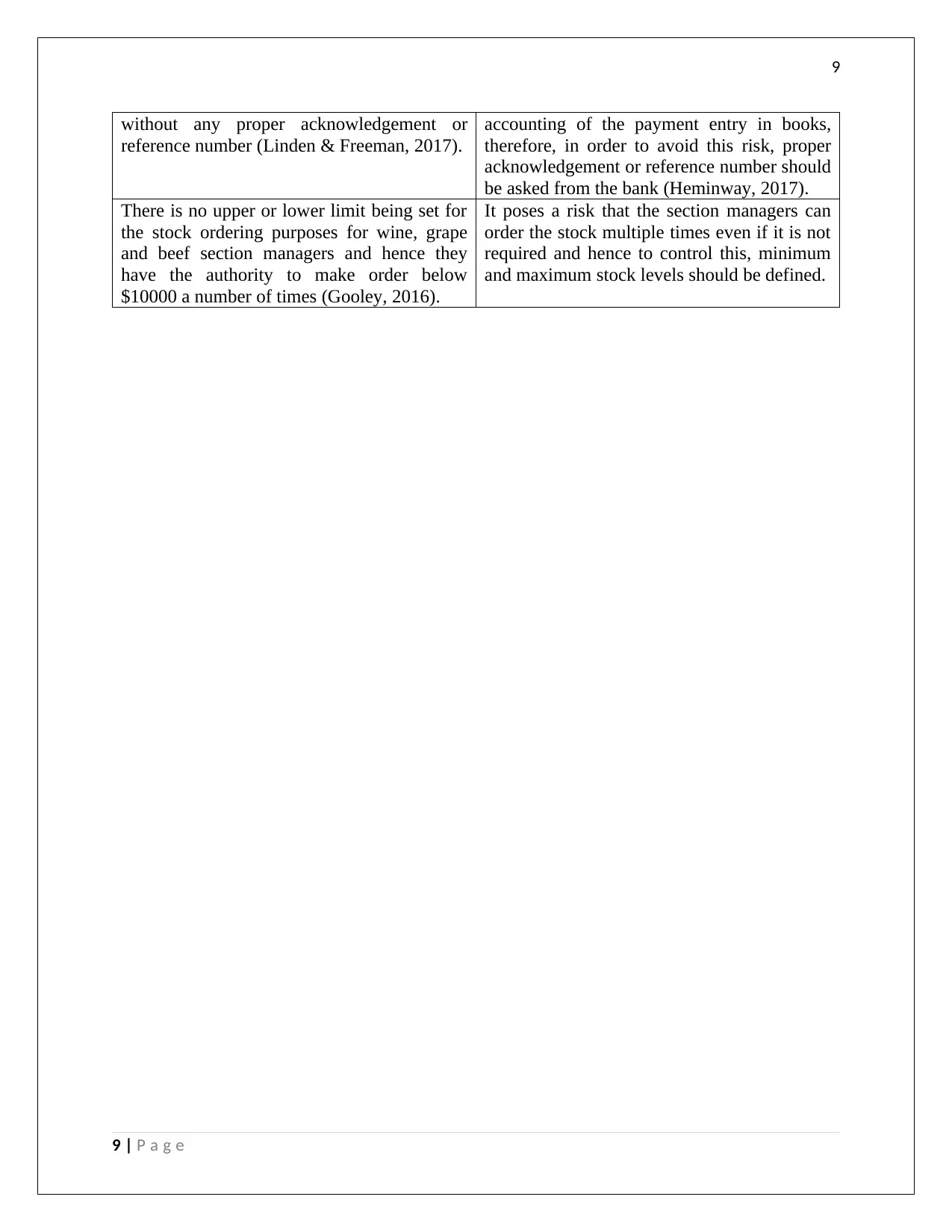
9
without any proper acknowledgement or
reference number (Linden & Freeman, 2017).
accounting of the payment entry in books,
therefore, in order to avoid this risk, proper
acknowledgement or reference number should
be asked from the bank (Heminway, 2017).
There is no upper or lower limit being set for
the stock ordering purposes for wine, grape
and beef section managers and hence they
have the authority to make order below
$10000 a number of times (Gooley, 2016).
It poses a risk that the section managers can
order the stock multiple times even if it is not
required and hence to control this, minimum
and maximum stock levels should be defined.
9 | P a g e
without any proper acknowledgement or
reference number (Linden & Freeman, 2017).
accounting of the payment entry in books,
therefore, in order to avoid this risk, proper
acknowledgement or reference number should
be asked from the bank (Heminway, 2017).
There is no upper or lower limit being set for
the stock ordering purposes for wine, grape
and beef section managers and hence they
have the authority to make order below
$10000 a number of times (Gooley, 2016).
It poses a risk that the section managers can
order the stock multiple times even if it is not
required and hence to control this, minimum
and maximum stock levels should be defined.
9 | P a g e
Paraphrase This Document
Need a fresh take? Get an instant paraphrase of this document with our AI Paraphraser
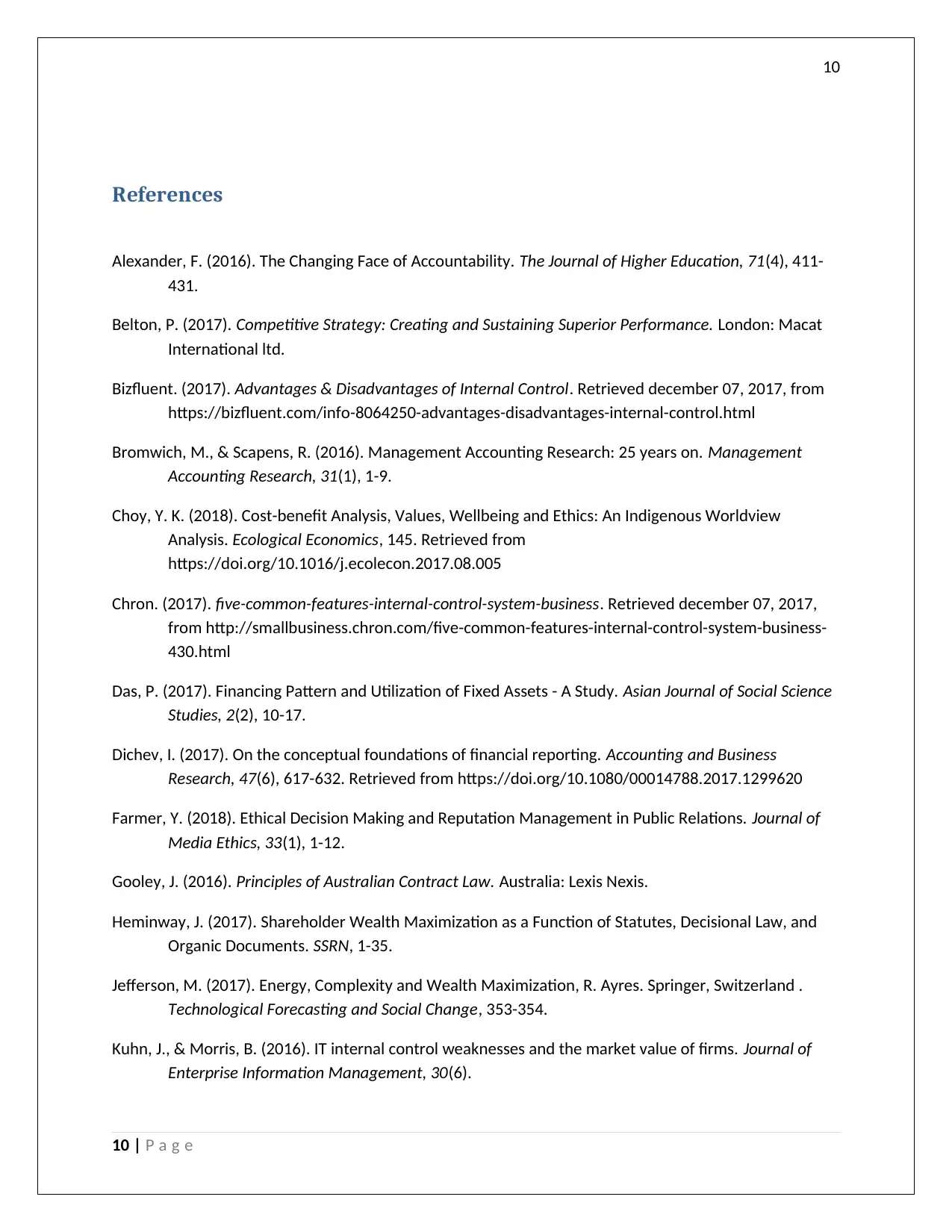
10
References
Alexander, F. (2016). The Changing Face of Accountability. The Journal of Higher Education, 71(4), 411-
431.
Belton, P. (2017). Competitive Strategy: Creating and Sustaining Superior Performance. London: Macat
International ltd.
Bizfluent. (2017). Advantages & Disadvantages of Internal Control. Retrieved december 07, 2017, from
https://bizfluent.com/info-8064250-advantages-disadvantages-internal-control.html
Bromwich, M., & Scapens, R. (2016). Management Accounting Research: 25 years on. Management
Accounting Research, 31(1), 1-9.
Choy, Y. K. (2018). Cost-benefit Analysis, Values, Wellbeing and Ethics: An Indigenous Worldview
Analysis. Ecological Economics, 145. Retrieved from
https://doi.org/10.1016/j.ecolecon.2017.08.005
Chron. (2017). five-common-features-internal-control-system-business. Retrieved december 07, 2017,
from http://smallbusiness.chron.com/five-common-features-internal-control-system-business-
430.html
Das, P. (2017). Financing Pattern and Utilization of Fixed Assets - A Study. Asian Journal of Social Science
Studies, 2(2), 10-17.
Dichev, I. (2017). On the conceptual foundations of financial reporting. Accounting and Business
Research, 47(6), 617-632. Retrieved from https://doi.org/10.1080/00014788.2017.1299620
Farmer, Y. (2018). Ethical Decision Making and Reputation Management in Public Relations. Journal of
Media Ethics, 33(1), 1-12.
Gooley, J. (2016). Principles of Australian Contract Law. Australia: Lexis Nexis.
Heminway, J. (2017). Shareholder Wealth Maximization as a Function of Statutes, Decisional Law, and
Organic Documents. SSRN, 1-35.
Jefferson, M. (2017). Energy, Complexity and Wealth Maximization, R. Ayres. Springer, Switzerland .
Technological Forecasting and Social Change, 353-354.
Kuhn, J., & Morris, B. (2016). IT internal control weaknesses and the market value of firms. Journal of
Enterprise Information Management, 30(6).
10 | P a g e
References
Alexander, F. (2016). The Changing Face of Accountability. The Journal of Higher Education, 71(4), 411-
431.
Belton, P. (2017). Competitive Strategy: Creating and Sustaining Superior Performance. London: Macat
International ltd.
Bizfluent. (2017). Advantages & Disadvantages of Internal Control. Retrieved december 07, 2017, from
https://bizfluent.com/info-8064250-advantages-disadvantages-internal-control.html
Bromwich, M., & Scapens, R. (2016). Management Accounting Research: 25 years on. Management
Accounting Research, 31(1), 1-9.
Choy, Y. K. (2018). Cost-benefit Analysis, Values, Wellbeing and Ethics: An Indigenous Worldview
Analysis. Ecological Economics, 145. Retrieved from
https://doi.org/10.1016/j.ecolecon.2017.08.005
Chron. (2017). five-common-features-internal-control-system-business. Retrieved december 07, 2017,
from http://smallbusiness.chron.com/five-common-features-internal-control-system-business-
430.html
Das, P. (2017). Financing Pattern and Utilization of Fixed Assets - A Study. Asian Journal of Social Science
Studies, 2(2), 10-17.
Dichev, I. (2017). On the conceptual foundations of financial reporting. Accounting and Business
Research, 47(6), 617-632. Retrieved from https://doi.org/10.1080/00014788.2017.1299620
Farmer, Y. (2018). Ethical Decision Making and Reputation Management in Public Relations. Journal of
Media Ethics, 33(1), 1-12.
Gooley, J. (2016). Principles of Australian Contract Law. Australia: Lexis Nexis.
Heminway, J. (2017). Shareholder Wealth Maximization as a Function of Statutes, Decisional Law, and
Organic Documents. SSRN, 1-35.
Jefferson, M. (2017). Energy, Complexity and Wealth Maximization, R. Ayres. Springer, Switzerland .
Technological Forecasting and Social Change, 353-354.
Kuhn, J., & Morris, B. (2016). IT internal control weaknesses and the market value of firms. Journal of
Enterprise Information Management, 30(6).
10 | P a g e
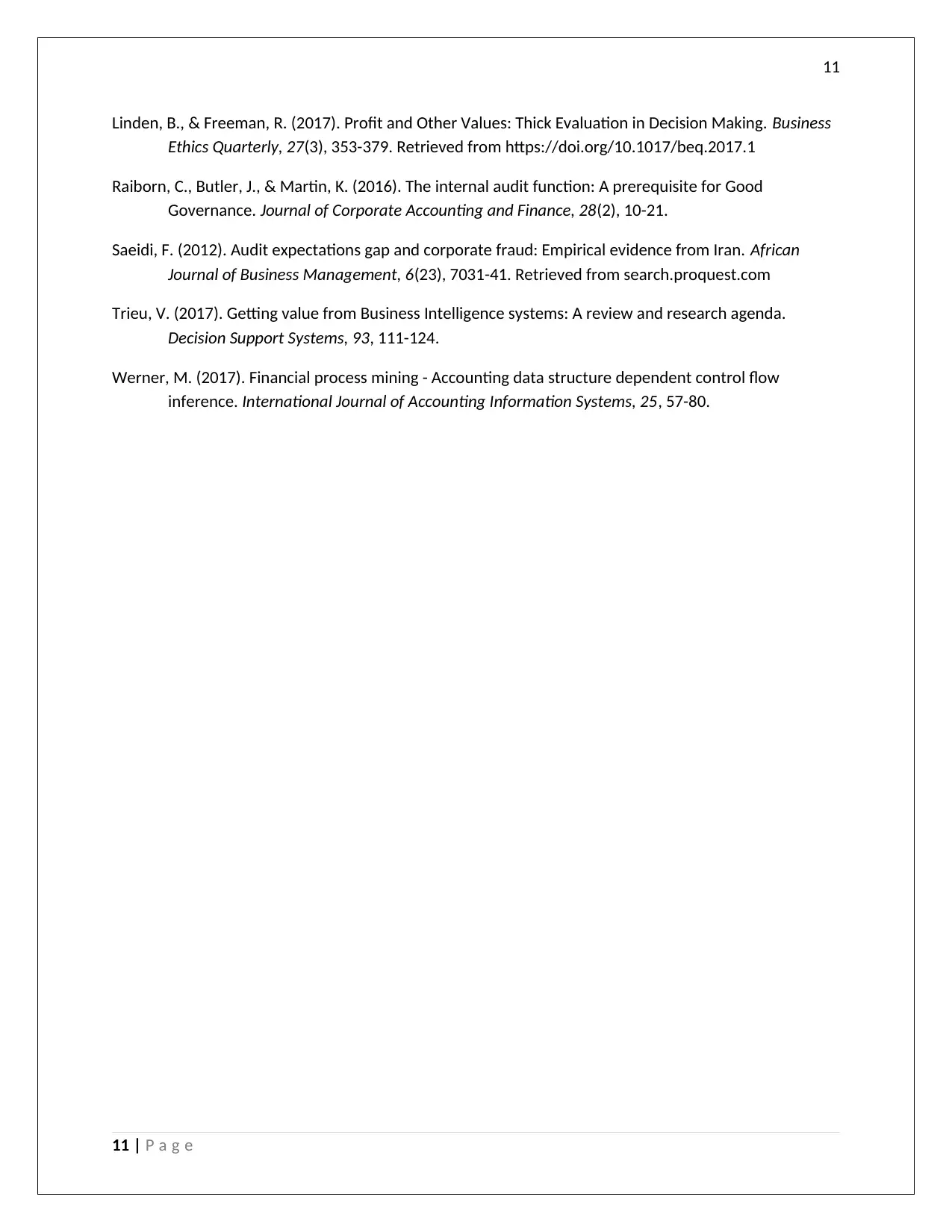
11
Linden, B., & Freeman, R. (2017). Profit and Other Values: Thick Evaluation in Decision Making. Business
Ethics Quarterly, 27(3), 353-379. Retrieved from https://doi.org/10.1017/beq.2017.1
Raiborn, C., Butler, J., & Martin, K. (2016). The internal audit function: A prerequisite for Good
Governance. Journal of Corporate Accounting and Finance, 28(2), 10-21.
Saeidi, F. (2012). Audit expectations gap and corporate fraud: Empirical evidence from Iran. African
Journal of Business Management, 6(23), 7031-41. Retrieved from search.proquest.com
Trieu, V. (2017). Getting value from Business Intelligence systems: A review and research agenda.
Decision Support Systems, 93, 111-124.
Werner, M. (2017). Financial process mining - Accounting data structure dependent control flow
inference. International Journal of Accounting Information Systems, 25, 57-80.
11 | P a g e
Linden, B., & Freeman, R. (2017). Profit and Other Values: Thick Evaluation in Decision Making. Business
Ethics Quarterly, 27(3), 353-379. Retrieved from https://doi.org/10.1017/beq.2017.1
Raiborn, C., Butler, J., & Martin, K. (2016). The internal audit function: A prerequisite for Good
Governance. Journal of Corporate Accounting and Finance, 28(2), 10-21.
Saeidi, F. (2012). Audit expectations gap and corporate fraud: Empirical evidence from Iran. African
Journal of Business Management, 6(23), 7031-41. Retrieved from search.proquest.com
Trieu, V. (2017). Getting value from Business Intelligence systems: A review and research agenda.
Decision Support Systems, 93, 111-124.
Werner, M. (2017). Financial process mining - Accounting data structure dependent control flow
inference. International Journal of Accounting Information Systems, 25, 57-80.
11 | P a g e
⊘ This is a preview!⊘
Do you want full access?
Subscribe today to unlock all pages.

Trusted by 1+ million students worldwide
1 out of 12
Related Documents
Your All-in-One AI-Powered Toolkit for Academic Success.
+13062052269
info@desklib.com
Available 24*7 on WhatsApp / Email
![[object Object]](/_next/static/media/star-bottom.7253800d.svg)
Unlock your academic potential
Copyright © 2020–2025 A2Z Services. All Rights Reserved. Developed and managed by ZUCOL.




